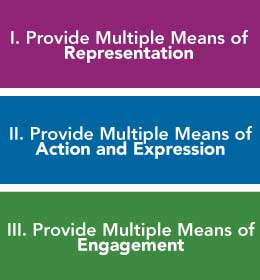4.3 Universal Design For Learning
1. Introduction: Universal Design For Learning
To listen to this introduction, click the audio link below
Developing a deep understanding of learner diversity is the first step toward meeting the needs of all the students in your classroom. With diversity in mind, educators can begin to create lessons that reduce the barriers to learning and include support structures that make learning possible for all students, we call this Universal Design for Learning.
The central idea behind Universal Design for Learning (UDL) is that instruction is designed to be “smart from the start.” In our design of instruction, we create lessons, activities, tests, and materials that can be used by diverse students, or those with many different abilities, preferences, and characteristics. As we deliver instruction, we provide different ways for individuals to receive information and interact with information. As we assess what students know and have learned, we consider options that enable all learners to fully show what they know.

To take an example from the world around us, consider curb cuts. Curb cuts were installed to enable people who use wheelchairs to move more freely throughout the environment. Curb cuts remove the barrier to sidewalk access and egress. But the truth is we all take advantage of this design when biking or pushing a stroller or wheeling our luggage behind. This is an example of universal design. Our task is to create curb cuts for education. That is, universally designed instruction that removes the barriers and benefits everyone—not just students with disabilities.
.
Special education often involves making adjustments to meet the needs of individuals with disabilities. In the classroom, these adjustments may entail differentiated instruction, individualized instruction, accommodations, modifications—or other commonly-used practices. It is important to realize that UDL is a different idea—we are not taking standardized instructional practices and retrofitting them to meet the needs of individuals with disabilities. Rather, we design instruction—from the start—that is appropriate for the needs and characteristics of all of the students in our classrooms—including those with disabilities.

Goals:
- Prepare educators to create a supportive and inclusive learning environment where all students successfully participate and learn.
- Understand the need to proactively design instructional opportunities to eliminate barriers and include curriculum enablers that support students in the margins.
Objectives:
- List the 3 principles of Universal Design for Learning.
- Describe UDL's critical elements and their impact on designing instruction.
- Apply the principles of Universal Design for Learning to a lesson.